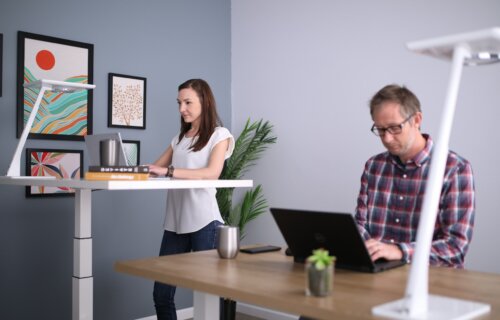LONDON — Standing desks can improve workers’ performance as well as cut their time sitting by an hour each day, according to new research. Study authors add that getting up from an office chair also boosts well-being and energy levels, while reducing stress.
“Office based workers spend most of their working day sitting and also show high levels of sitting time outside of work,” says corresponding author Dr. Charlotte Edwardson from the University of Leicester in a statement, according to SWNS.
“High levels of sitting time are associated with several health related outcomes and premature mortality, with high levels of workplace sitting associated with low vigor and job performance and high levels of presenteeism.”
Presenteeism is the practice of being present at one’s place of work for more hours than is required, especially as a manifestation of insecurity about one’s job. Sedentary lifestyles increase the risk of chronic conditions including cardiovascular disease, type 2 diabetes, depression, anxiety, and cancer.
Office employees typically do the least exercise, spending three-quarters of their shifts and two-thirds of their waking day sitting in a chair.
“This study was a key research-to-translation step,” Dr. Edwardson tells SWNS.
Previous studies looking at ways to reduce sitting in the workplace have only come up with low-quality solutions. The team’s SMART Work & Life (SWAL) intervention was designed to reduce sitting time and increase moving time at work, with and without a standing desk, delivered by workplace champions.
Adding a standing desk triples your standing time each day
The trial involved 756 U.K. office workers from two councils in Leicester, three in Greater Manchester, and one in Liverpool. Participants were randomly assigned to the SWAL group, the SWAL intervention with a standing desk, or a control group over a 12-month period.
The SWAL intervention group received a range of resources to help them reduce their sitting time and highlight the health risks of too much sitting. Workplaces were also encouraged to make small changes around the office to enable more movement, such as relocating printers and wastepaper bins and creating standing areas for meetings.
The SWAL-plus-desk group also received a height adjustable desk to encourage less sitting time. The control group carried on working as usual. Workers’ sitting time was measured using an accelerometer worn on the thigh at the outset and again 12 months later. Daily physical activity levels, and self-reported feedback about work, physical, and mental health was also recorded.
The standing desk was three times more effective at reducing sitting time than the SWAL intervention alone. For example, at 12 months, daily sitting time for the SWAL group, and the SWAL-plus-standing desk were, respectively, 22 minutes and 64 minutes lower on average than the control group each day.
“The SWAL plus desk group sat for 42 minutes less daily than the SWAL group, showing it to be more effective,” researchers say, according to SWNS. “Time spent in prolonged sitting was lower in both intervention groups compared with the control group. Reductions in sitting time were largely replaced by increases in standing time, and these changes occurred on workdays and during work hours.”
“Furthermore, the magnitude of behavior change was similar across the three and 12 month follow-up, indicating that behavior change was maintained during the course of the study,” study authors continue. “Finally, the SWAL plus desk intervention appeared more effective during work hours for those older than the average age.”
The trend of remote work could present a problem
The average age of participants was 45. More than seven in 10 were women. Average body mass index (BMI) at the start of the study was 26.5.
The researchers found a small, but non-clinically meaningful improvements in stress, well-being, and a sense of work-related vigor for both intervention groups compared with the control group at three and 12 months, as well as more pain in the hips, knees, and ankles in the desk group.
Although time spent sitting was lower in both intervention groups compared with the control group, the researchers note that most participants simply replaced sitting with standing. They say further work is necessary to encourage more physical activity, particularly outside of working hours.
The team points to areas for future research, such as exploring how people can best be supported to make changes outside of work and increase time spent moving, across different employment sectors and for a longer time period.
“The findings are noteworthy because they come from a fully powered cluster randomized trial with objective measurement of sedentary behavior at three and 12 months,” says Professor Cindy Gray from the University of Glasgow, who did not take part in the study, in a media release.
However, Gray points out that the move to more home-based and blended patterns of working after the COVID-19 pandemic is likely to increase workforce sedentariness.
“Understanding how to optimize occupational interventions to support people to sit less and move more around their home during both work and non-working hours is essential,” Prof. Gray adds.
South West News Service writer Mark Waghorn contributed to this report.

